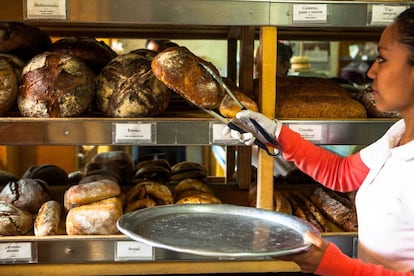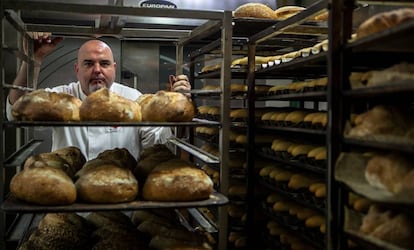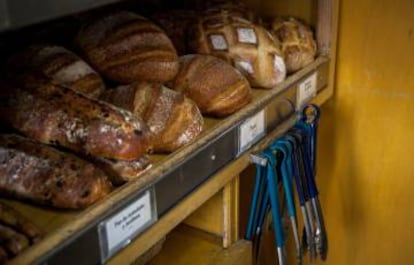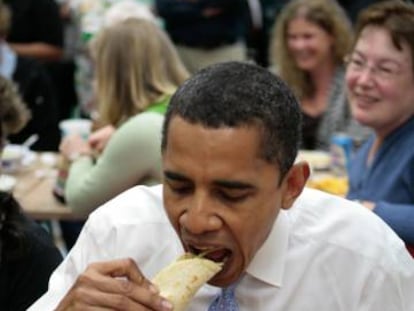The rise of bread in the empire of corn
Wheat consumption is growing in Mexico, with thousands of bakeries offering artisan bread

Tongs in hand, Sandra Allende, 65, walks decisively towards her favorite bread, a baguette paysanne. It is noon at one of Mexico City’s most popular bakery chains, and Sandra is in a hurry: her three grandchildren are coming over for lunch. “I already have the tortillas. I’ve rushed over for the bread. I buy a baguette nearly every day. My husband loves to dip it in stews.”

In Mexico, the legendary cradle of corn, the latter lives in peaceful coexistence with wheat. But the younger brother is starting to grow up fast.
After tripping last year over a tax on processed food, including industrial baked goods, consumption of wheat products has been rising to a record 116 million tons, according to the industry group Canainpa.
The fastest-growing segment, at 3%, is artisan bread. Nearly 37,000 small bakeries have opened up in the country in recent years.
We need to abandon our prejudices that bread is fattening and bad for you
Joan Bagur, baker
“These businesses tend to be concentrated in higher-income areas. In the popular neighborhoods, people still eat mostly corn, but this new eating habit is also making inroads, based on slower-fermentation breads that use natural yeast and have a hard crust, following European tastes,” explains Canainpa president Carlos Otegui.
Eduardo Da Silva, the son of Portuguese and Mexican parents, is one of the pioneers in the crusade to bring artisan bread to the country. Two decades ago, the umpteenth crisis put an end to his shoe business, and he decided to take cooking lessons with a French instructor.
Seventeen years, six shops and 100 kilograms of bread a month later, Da Silva recalls his own beginnings in the industry: “Industrialization had annihilated neighborhood bakeries. I decided to go back to the recipes of old, using sourdough and long preparation times. Spaniards, Germans and French people began to show up, recognizing this bread as something familiar.”

There is a global yearning for old-fashioned recipes and healthier foods, and a market for those who can afford it. “From Europe to New Zealand, people are tired of eating unhealthy things,” notes Da Silva. “And even the large chains are trying to get into that niche by selling what they call artisan bread, even though it is, in fact, the same as commercial bread. They add industrial yeast or sugar to speed up fermentation and to give the crust that darker color.”
At the bakery department of Walmart, Superama and Chedruai, three of Mexico’s largest supermarkets, it is now easy to find whole-wheat bread. Some retailers like El Globo have even launched a German-looking line, delibröt, and also offers San Francisco sourdough bread, and multicereal bread studded with pumpkin seeds or black olives from Morocco.
But Elena Reygadas, winner of the 2014 50Best award to best chef in Latin America, and head of two bakeries and two restaurants, feels that “bread should not be an elite product.”

She defends the bread tradition that arrived in Mexico with the Spanish Conquistadors, from the telera or bolillo breads, common in central Mexico, to the slightly acidic tortas of Jalisco, good for dipping in tomato sauce, or the wheat tortillas made in the northern states.
Sonora and Baja California are the main producers, but Mexico still needs to import around 60% of national consumption, mostly from the United States.
“We use imported flour becase it guarantees that it does not have pesticides and because they supply us with different ancestral forms of wheat,” explains Bernardo Flores, a partners at BreAd bakery in Monterrey, where they have been making sourdough bread for six years.
“Flour, salt, water, and then we let it thrive in the ecosystem created with yeast and natural bacteria, at stable temperatures. This gives you more nutritious bread that is easier to digest,” he says.
“The market in Mexico is growing. We need greater specialization and to abandon our prejudices that bread is fattening and bad for you,” says Joan Bagur, who supplies bread to hotels, restaurants and catering firms in the capital.
But perhaps the most vivid image of Mexican syncretism when it comes to both cereals is to be found at the street food stands, where people stand in line in the morning to buy a torta de tamal: a rectangle of corndough stuffed into a piece of white bread.
English version by Susana Urra.
Tu suscripción se está usando en otro dispositivo
¿Quieres añadir otro usuario a tu suscripción?
Si continúas leyendo en este dispositivo, no se podrá leer en el otro.
FlechaTu suscripción se está usando en otro dispositivo y solo puedes acceder a EL PAÍS desde un dispositivo a la vez.
Si quieres compartir tu cuenta, cambia tu suscripción a la modalidad Premium, así podrás añadir otro usuario. Cada uno accederá con su propia cuenta de email, lo que os permitirá personalizar vuestra experiencia en EL PAÍS.
¿Tienes una suscripción de empresa? Accede aquí para contratar más cuentas.
En el caso de no saber quién está usando tu cuenta, te recomendamos cambiar tu contraseña aquí.
Si decides continuar compartiendo tu cuenta, este mensaje se mostrará en tu dispositivo y en el de la otra persona que está usando tu cuenta de forma indefinida, afectando a tu experiencia de lectura. Puedes consultar aquí los términos y condiciones de la suscripción digital.
More information
Archived In
Últimas noticias
The complicated life of Francesca Albanese: A rising figure in Italy but barred from every bank by Trump’s sanctions
How Japan is trying to avert ‘digital defeat’
Half of Scotland is in the hands of 420 property owners
Reinhard Genzel, Nobel laureate in physics: ‘One-minute videos will never give you the truth’
Most viewed
- Pablo Escobar’s hippos: A serious environmental problem, 40 years on
- Reinhard Genzel, Nobel laureate in physics: ‘One-minute videos will never give you the truth’
- Why we lost the habit of sleeping in two segments and how that changed our sense of time
- Charles Dubouloz, mountaineering star, retires at 36 with a farewell tour inspired by Walter Bonatti
- The Florida Keys tourist paradise is besieged by immigration agents: ‘We’ve never seen anything like this’










































